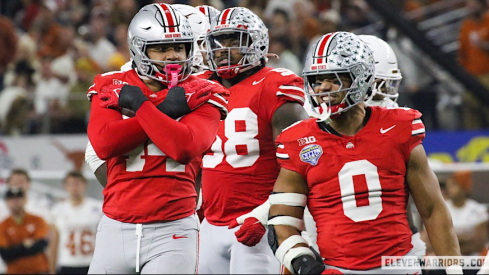
College athletics has always been about the haves and have-nots. Nowhere is it more true than the money grab of football. Conference expansion, ballooning coaches contracts, TV deals in the billions of dollars – the evidence is at every turn.
In the future, the sport could literally be split between haves and have-nots. The talk of super-conferences breaking away from the NCAA has floated on the periphery for several years – not absurd, but not anything imminent, either. But when Nick Saban expresses his wishes, which he did last week, ears perk up and important people tend to listen.
“I’m for five conferences, everybody playing everybody in those five conferences,” Saban told AL.com. “That’s what I’m for, so it might be 70 teams, and everybody’s got to play them.”
It would set off a cataclysmic event in the college football world, effectively splintering the SEC, Big Ten, Big 12, Pac-12, ACC and Notre Dame from the rest of the sport.
The rich would get richer while the MAC and all the others left behind would be rendered irrelevant. The shockwaves would be felt across the college football landscape, but perhaps that boom would be loudest in places like Boise.
Since moving to the FBS level in 1996, Boise State has steadily progressed up the respectability ladder. The program still remains among the most polarizing in the sport, some say the Broncos belong among the elite while others scoff at the idea of a little state school in Idaho being on par with the Ohio States and Alabamas of the world.
It might not be in one of the power conferences, but Boise State has proven over the years it can beat anyone – and it will play anyone anywhere, a quality missing from most of the big-time programs. The Broncos recently agreed to a TV deal with ESPN and are in the process of upgrading their facilities to keep up with the sport’s Goliaths.
When the College Football Playoff arrives in 2014, Boise State will finally have the opportunity it never received in the archaic BCS: a chance at hoisting the crystal football.
But if Saban’s vision comes to fruition, the Broncos won’t only be eliminated from championship contention, they’ll be ostracized from the haves in college football. The Big Ten indicated last year that all of its member institutions would beef up the non-conference schedules, but Saban’s suggestion opens up a Pandora’s box.
The financial implications appear first on the radar. The Bowling Greens and Louisiana-Lafayettes would be hamstrung and left bobbing in an open ocean full of sharks. The affects would ripple down the college football food chain to FCS, where Youngstown State and others rely on guarantee games to help fund their athletic departments. Already, lower-tier schools’ budgets have been stricken because there’s reluctance by big schools to continue shelling out million-dollar paydays for games. Nine-game conference schedules also give mid-major teams fewer games against big programs that involve large payouts.
Ohio State athletic director Gene Smith told Eleven Warriors that the more likely scenario would be a separate division within the NCAA for the power conferences. The idea would be having a different set of rules for the 60-70 schools that make up the five superconferences.
“I do think there could be a different governing structure for the top schools, underneath the NCAA umbrella.” – Gene Smith
“I do not see schools breaking away from the NCAA. I do think there could be a different governing structure for the top schools, underneath the NCAA umbrella,” Smith said. “A structure that allows those schools to have its own legislation, like the stipend issue where MAC and other schools cannot pay it but the top 60-70 can.”
Another hindrance, as Smith alluded to, is the looming possibility of $2,000 stipends or even expenditures that cover the full cost of attendance. The NCAA chose not to pass the former last year, upsetting many athletic directors and conference commissioners.
“It’s a disappointment that it’s not taken care of yet,” the SEC’s Mike Slive said. “We truly believe that we ought to do more for our student-athletes than just the room, board, books and tuition. We’re hopeful that we can continue to make that work. ... I think it's fair to say it's an idea that's not going to go away.”
NCAA President Mark Emmert supports the stipend plan and will unveil another proposal in October with hopes that the Division I Board of Directors will give it the OK. Sidney McPhee, the president of Middle Tennessee State and head of the committee in charge of the stipend, doesn’t think every institution can come to an agreement on the issue.
“There are some people who will oppose anything he supports, and that's unfair,” he told The Chronicle of Higher Education. But McPhee also indicated that universities regularly increase aid to students in the general population. Some see a double standard when it comes to spending money on college athletics.
“If you want to compete, you've got to step up,” McPhee said.
When skyrocketing coaching salaries are examined, it appears some schools have not only stepped up to the plate but hit home runs. Still, money remains an issue with student-athletes due to opinions on amateurism and smaller schools not having the bank account of Ohio State and Texas. Title IX compliance could also play a factor.
“Title IX issues have ways to be balanced,” Smith said. “That is why the stipend has to be for all student-athletes.”
In a way, there’s already an existing divide. The BCS had a closed-door policy to the little guys, only allowing them in under extreme circumstances while the new College Football Playoff will split more than 70 percent of its revenue among the SEC, Big Ten, Big 12, Pac-12, and ACC.
There are also conference networks, and even the Longhorn network, dedicated solely to the University of Texas, that continue to boost athletic department funding. The SEC announced the launching of its own network this month that could involve $30 million annually to its 14 members, and it was announced last week that Big Ten members received a record payout of $25.7 million. Well over half of that came from media rights deals with ABC/ESPN and the Big Ten Network.
But where the haves could be hurt in the pocketbook is the ongoing Ed O’Bannon lawsuit. O’Bannon v. NCAA involves former UCLA basketball standout Ed O’Bannon and several other former athletes who don’t believe the NCAA should profit from their names and likeness without getting a piece of the royalty pie.
The multi-billion dollar outcome has college sports’ powerbrokers nervous. Big Ten commissioner Jim Delany even made the silly comment about the conference being relegated to Division III if the NCAA lost the case. That’s not to say a ruling in favor of O’Bannon wouldn’t signal dramatic changes - possibly dropping sports - but chatter involving blue-blood programs moving to the Division III model is nothing more than fear mongering and insulting the intelligence of media and fans.
“The O’Bannon case would basically force schools to develop different funding models and sports would be hurt drastically,” said Smith, with emphasis on the word hurt.
But even in a charred landscape in the wake of an O’Bannon victory, college athletics will stay on course regarding the haves and have-nots.

